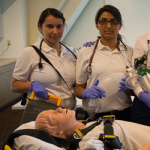Veterinary Assistants in the Workplace
Once they reach the appropriate education, veterinary assistants can find jobs in veterinary clinics and animal hospitals.
These are the places where they are frequently found working.
However, there are some other career opportunities for vet assistants.
They can work in animal or biomedical research laboratories, research and teaching institutions, shelter medicine, and zoo or wildlife medicine.
Veterinary assistants typically work full or part-time, and those who work in 24-hour facilities such as emergency animal hospitals will have to work evenings, nights, weekends, or holidays.
Duties
These are just some of the responsibilities of veterinary assistants:
- They need to take care of the daily needs of the animals such as feeding, walking, and providing water and clean bedding
- Furthermore, they are in charge of cleaning and disinfecting animal cages, exam rooms, and treatment areas
- Also, vet assistants maintain surgical equipment, sterilize surgical instruments, and assist the veterinarian during a surgery
- They administer medications to patients and properly restrain patients for blood/urine collection and tissue sampling for testing
- Some of them also perform laboratory tests such as urinalysis setup, operation of automated blood machines, fecal exams, etc.
- When administration duties are in question, they must maintain patient charts that document daily care
Animal care is not the only service they provide.
Veterinary assistants also have to work closely with pet owners, as they are the first people pet owners meet when calling or coming to a pet hospital.
So as to make sure that the overall veterinary hospital experience is pleasant, veterinary assistants must be comfortable with people and equipped with good communication skills.
They are those who inform clients about various diseases, medication administration, and general pet care.
The survey done by the American Veterinary Medical Association claims that pets are members of the family in more than 71% of households in the United States and that households have an average of 2-3 pets.
Thus, vet assistants have both the reward and satisfaction of assisting animals and their owners.
Salary
If we take into consideration the US Bureau of Labor Statistics’ data, the median annual salary for veterinary assistants is $29,780.
However, their salary depends on numerous factors and can range from around $22,920 to around $38,860.
According to the 2015 Firstline Career Path Survey, the average hourly wage for veterinary assistants is $14.23.
How much they will earn highly depends on the number of doctors in the practice and the type of practice.
If you want to earn more, you should look for a job in a research facility, as it pays higher salaries than clinical or hospital settings.
Of course, veterinary assistants with years of experience will get higher salaries.
Those who are finishing their vet assistant education should not worry about whether they will find a job, being that the veterinary industry is constantly growing due to the increasing number of pet owners in the US.
Plus, the number of responsible pet owners is also increasing, causing a huge demand for veterinary assistants.
In the years to come, the employment for veterinary assistants is expected to grow at a rate of 9%.
Annually National Average Salary: $31,780
Average Annual Salary by State
| State | Avg. Annual Salary |
|---|---|
| Alabama | $26,420 |
| Alaska | $36,450 |
| Arizona | $32,180 |
| Arkansas | $27,800 |
| California | $36,350 |
| Colorado | $32,920 |
| Connecticut | $32,480 |
| Delaware | $33,040 |
| Florida | $29,990 |
| Georgia | $29,500 |
| Hawaii | $35,870 |
| Idaho | $26,650 |
| Illinois | $31,690 |
| Indiana | $28,840 |
| Iowa | $32,500 |
| Kansas | $27,700 |
| Kentucky | $26,270 |
| Louisiana | $26,420 |
| Maine | $40,900 |
| Maryland | $35,490 |
| Massachusetts | $39,140 |
| Michigan | $30,410 |
| Minnesota | $35,510 |
| Mississippi | $25,140 |
| Missouri | $29,710 |
| Montana | $28,930 |
| Nebraska | $29,980 |
| Nevada | $30,230 |
| New Hampshire | $31,870 |
| New Jersey | $33,420 |
| New Mexico | $29,130 |
| New York | $36,850 |
| North Carolina | $30,940 |
| North Dakota | $29,200 |
| Ohio | $29,420 |
| Oklahoma | $27,560 |
| Oregon | $34,580 |
| Pennsylvania | $30,690 |
| Rhode Island | $38,850 |
| South Carolina | $30,940 |
| South Dakota | $29,410 |
| Tennessee | $28,480 |
| Texas | $28,410 |
| Utah | $27,510 |
| Vermont | $31,130 |
| Virginia | $30,500 |
| Washington | $35,880 |
| West Virginia | $26,160 |
| Wisconsin | $28,270 |
| Wyoming | $30,940 |
| Puerto Rico | $18,860 |
Annual Average Salary: Top 5 States
The top earning state in the field is Maine, where the average salary is $40,900.
These are the top 5 earning states in the field:
* Employment conditions in your area may vary.
Steps to Become a Veterinary Assistant
Step 1 Get your high school diploma or GED
Our first suggestion is to earn a certificate through a non-degree program that can be attended either at a college or online.
It is true that certification is not required, but according to the employers who prefer to hire veterinary assistants who have an associate’s or bachelor’s degree in animal science or a similar field, you will have better chances of employment if you have one.
Step 2 Get training on the job
Another way towards this new career is getting the appropriate training on the job.
This training is provided by colleagues who are more experienced and are in charge of training veterinary assistants in animal care, laboratory skills, and front desk administrative tasks.
When animal care is in question, it involves the training of the following skills:
- Feeding
- Watering
- Patient restraint
- Monitoring animals for issues
- Cleaning and disinfecting cages and work areas
- Sterilizing laboratory equipment and surgical instruments
- Providing post-operative care
- Administering oral and topical medications
- Preparing specimens for lab examination
Furthermore, front desk training is related to:
- Assisting customers over the phone
- Interacting with clients when they visit the clinic
- Utilization of practice management software to manage client and patient records
Step 3 Consider an optional certification
As we have already mentioned, certification is not required.
The reason why you should get it is that it is preferred by employers.
You can take into consideration optional certifications that can be obtained through state veterinary societies and private organizations.
It is important to get familiar with requirements that may vary by program.
However, the majority of them require educational coursework, hands-on training with veterinarians and veterinary technicians, and a final written examination.
Step 4 Explore opportunities for advancement
Those who are the most persistent and advanced decide to advance their careers in animal welfare.
They achieve this by obtaining further education and certification, and by going back to school to complete either an associate’s degree or a veterinary technician program.
Some of them even decide that completing a bachelor’s degree with pre-veterinary requirements, allowing them to apply to veterinary school is the right career path.
It is worth mentioning that acceptance to veterinary school is highly competitive, and their experience working as a veterinary assistant will be their advantage for admission.
Popular Programs
Explore Degree Paths
You should get familiar with what your possible employer expects from you when education requirements are in question, as many veterinary assistants can get the training on the job at clinics and hospitals, but there are also those employers who would require assistants to hold a high school degree or GED, as well as certificate prior to becoming employed.
If you are a high school student who is eager to prepare for this career, you can take classes in office operations, communications, and life and physical sciences.
Plus, you can gain volunteer experience with animals.
There are high school career centers that offer training and certificate programs in veterinary assisting.
Video About The Career
Certification & Licensing
In case you want to get employed by larger and specialty practices, you have to know that they hire only those veterinary assistants who are certified by the National Association of Veterinary Technicians in America (NAVTA).
So as to get certified, you will have to complete a NAVTA-approved veterinary assistant program.
You can enroll in any of the NAVTA currently approved programs – 29 on-campus and 3-distance programs.
Also, you can obtain appropriate knowledge through a program that is not NAVTA-accredited.
It is true that this program will not provide you with certification, but you will be equipped with some useful skills and training
Universities, community colleges, technical colleges, career schools, high schools, and veterinary hospitals all offer vet assistant certificate programs.
Whatever degree path you should take depends on you, but you can always check with other veterinarians and assistants in your area and find out what is necessary to get employment in this field.
Students complete a series of courses covering the following:
- Veterinary medical terminology – during which they will study vocabulary related to animal anatomy, physiology, and diagnostic testing.
- Restraint and handling – as they will need to know how to handle common species safely and perform nail trimmings and bathing.
- Surgical Nursing and care – as they must know how to properly prepare a room for surgery, how to assist vets and techs during the procedure, and provide nursing care to patients.
- Laboratory and clinical procedures – they must learn to assist vets and vet techs with imaging studies and lab tests.
Students are also required to complete an internship at a veterinary clinic.
This is a significant part of the education process due to the fact that it is the only way to practice handling, restraint, surgical prep, lab techniques, and office operations.
Average Training Program Duration: 0-6 Months
Job Outlook
Those who are finishing their vet assistant education should not worry about whether they will find a job, being that the veterinary industry is constantly growing due to the increasing number of pet owners in the US.
Plus, the number of responsible pet owners is also increasing, causing a huge demand for veterinary assistants.
In the years to come, the employment of veterinary assistants is expected to grow at a rate of 14%.
Employment Growth Projection: 14%
2020
2030
That's a higher than average projected growth of 15,300
Should You Become a Veterinary Assistant?
Overall Satisfaction: High

Overall Vet assistants are quite happy, most of them chose this line of work to be able to work closely with pets such as dogs and cats.
If you love animals, being around them most of the day surely will make your day brigther.
Average Salary: Medium

If you’re after big money, you should consider going after a higher-earning career, but if you want to work close to animals, without a lot of years of veterinary school and becoming a vet yourself, being a vet assistant is a quick way to get there.
It can also be a great job while going to school, for example, if you want to be a veterinarian, working as a vet assistant for the duration of your studies you will gain a lot of hands-on experience.
Job Growth Outlook: High

The population of pets in the U.S. is ever-growing, people like their pets, and they spend billions every year taking care of them.
In the next 10 years, the BLS estimates there will be 15,300 new vet assistants across the nation.
Education Duration: 0-6 Months

Becoming a vet assistant can take as little as 3-7 months, it depends on how quickly you go through all the stages of being certified as one.
Online programs are usually around 5 months.
Personal Skills Needed

- Physical fitness
- Focus and multitasking abilities
- Interpersonal skills
- Love of animals
- Ability to handle stress with poise
- Good temperament
Frequently Asked Questions
How quickly can I find work as a vet assistant?
It’s hard to say, it depends greatly on where you live.
Finding work in a big city will be easier as there are more vet clinics.
We can say that usually there is a lot of demand for vet assistants, but every metro area differs.
Should I work as a vet assistant while going to college?
Yes!
Supporting yourself while doing something you love can be a great way to pay for college.
 Veterinary Assistant Info by State
Veterinary Assistant Info by State

- Alabama
- Alaska
- Arizona
- Arkansas
- California
- Colorado
- Connecticut
- Delaware
- Florida
- Georgia
- Hawaii
- Idaho
- Illinois
- Indiana
- Iowa
- Kansas
- Kentucky
- Louisiana
- Maine
- Maryland
- Massachusetts
- Michigan
- Minnesota
- Mississippi
- Missouri
- Montana
- Nebraska
- Nevada
- New Hampshire
- New Jersey
- New Mexico
- New York
- North Carolina
- North Dakota
- Ohio
- Oklahoma
- Oregon
- Pennsylvania
- Rhode Island
- South Carolina
- South Dakota
- Tennessee
- Texas
- Utah
- Vermont
- Virginia
- Washington
- West Virginia
- Wisconsin
- Wyoming
Veterinary Assistant Resources
- 14 Pros and Cons of Being a Veterinary Assistant
- How Much Does It Cost to Become a Veterinary Assistant?
- Online Veterinary Assistant Training Programs
More Medical Careers
| Career | |
|---|---|
 | Certified Nursing Assistant Working as a Certified Nursing Assistant is an entry-level role that will give you hands-on experience when you are ready to take the next step in your medical career. |
 | Dental Assistant Dental assistants help dentists to provide patient care, keep records, and care for the dental equipment. |
 | Dental Hygienist Dental hygienists take care of cleaning teeth to promote hygiene and help avoid cavities and gum problems. |
 | Dialysis Technician Dialysis technicians maintain and monitor dialysis equipment, and also act as primary caregivers for patients undergoing dialysis treatment. |
 | Dog Groomer Dog groomers attend to grooming dogs, usually at dog salons or big pet-related chain stores. |
 | Healthcare Administrator Healthcare administrators – also known as healthcare executives or health services managers – are responsible for the planning, direction, and coordination of medical and health services. |
 | Home Health Aide Home health aides provide home care to individuals who require assistance in their day-to-day living. |
 | Licensed Practical Nurse (LPN) Licensed Practical Nurses provide basic nursing care to patients and work with Registered Nurses and Doctors. |
 | Medical Assistant Medical assistants support the work of physicians, nurses, and other health professionals. |
 | Medical Biller and Coder Medical billers and coders manage, organize, and code various health information data. |
 | Medical Technologist Medical laboratory technologists collect bodily samples and conduct tests to analyze those samples. |
 | Medical Transcriptionist Medical transcriptionists go over voice recordings to convert them into written texts. |
 | Nutritionist As a Nutritionist, you’ll be tasked with creating meal plans, counseling, and understanding dietary restrictions for all types of clients. |
 | Patient Access Representative The work involves helping people to orient themselves to the space and everything that is going on. |
 | Patient Care Technician Patient care techs work directly with patients helping them with daily activities and assist the medical staff by measuring and monitoring the patients' vital signs among other tasks. |
 | Pharmacy Technician Pharmacy technicians provide patients with medications through prescription or over the counter. |
 | Phlebotomist As a Phlebotomist, it will be your responsibility to take blood samples from patients and send them to the lab for further testing. |
 | Physical Therapist Assistant Physical therapist assistants provide physical therapy services to patients and aide to physical therapists. |
 | Professional Recovery Coach A professional recovery coach is a life coach who works with someone during their addiction recovery process. |
 | Radiation Therapist Allied health provisional who specializes in radiation oncology treatments. |
 | Registered Health Information Technician Registered Health Information Technician (RHIT) help store and verify accuracy of health records as well as analyze patient data. |
 | Registered Nurse (RN) Registered Nurses provide hands-on patient care in various settings, mainly hospitals, and clinics. |
 | Respiratory Therapist Respiratory therapists treat and care for patients who experience breathing difficulties. |
 | Sterile Processing Technician A sterile processing technician is a healthcare professional who is responsible for preparing, sterilizing, maintaining, packaging, and storing medical tools and equipment used in surgical and other medical procedures. |
 | Surgical Technologist Surgical technologists – also known as operating room techs – prepare operating rooms and assist doctors and nurses during surgical procedures. |
 | Veterinary Technician Veterinary Technicians assist veterinarians as well as diagnosing and treating animals, mostly in private clinics. |
 | EKG Technician EKG technicians test and monitor the cardiovascular system. |
 | EMT Trained emergency medical technician that arrives at the scene to provide medical services such as resuscitation. |
 | MRI Technologist MRI Technologists use a machine to scan the body and create a detailed image of the inside for doctors to analyze. |
 | Optician Opticians are technicians and salespersons at the same time who spends most of their day talking to customers, reading prescriptions written by doctors, and dispensing glasses and lenses. |
 | Ultrasound Technician Ultrasound technicians aid physicians in monitoring and diagnosing patients through the use of ultrasonic imaging technology. |
 | X-Ray Technician X-Ray Technicians are medical imaging professionals who use technology to visualize the inside of our bodies. |














